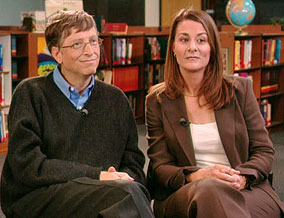As so many programs on education have done before this one, Oprah’s show Aug. 7 revealed much, but proposed little of value. All of us who teach are aware of the myriad of problems that mitigate our providing children with the education they need, but a unified approach to dealing with any of these issues is sorely lacking. Now the Gates family wants to throw some money at the issue. Like most previous solutions, this commendable effort will do some good somewhere, but falls short of addressing the overall problem, even when the diagnosis is correct.
As impressive as the Gates’ $51 billion dollar fortune is, it hardly justifies their superficial understanding of the issue.
Like so many theoreticians and talk show hosts seeking audiences, blame was delivered as scattershot in fog, blindly aimed and only occasionally on target. The deplorable
The basic problems with education are addressed daily, but sporadically. Those with workable solutions are largely unrecognized and scattered about the country. Those in charge of the educational apparatus are largely the result of academic semi-competence, political manipulations, non-competitive pay, and public apathy. The resulting scholastic bureaucracies tend to encourage uniform mediocrity while discouraging personal initiative.
Only in passing is the educational deficit attributed to an overall lack of reading emphasis in our schools. Most telling was the “Kid Swap” episode in which several students from inner city
That only 76 percent of the students in the $65 million school met
What we have, instead, is an expensive glossing-over of the true literacy issue. Immerse these richer kids with enough expensive media and entertaining instructors and something is bound to soak in. That “something” however, still leaves us far behind our European cohorts and many of our schoolchildren will likely stand by as we’re exceeded by several rising third-world countries who understand the shortcut to a good education---well, there is none. It’s hard work, something our over-mediated, over-medicated, overindulged, overweight, and over-schooled students cannot be made to understand.
Public schools cannot fix what’s wrong with American students because ultimately, they’re beholden to the driving force in this country, corporate consumerism. Unrealistically high expectations, fueled by a never-ending flood of overly optimistic ads and adult pandering has given us a predictable “product,” the fruits of our “affluenza.”
We get what we pay for, and in the case of education, we suffer because of it. Intrinsic motivation to read and learn cannot be bought; reluctant youngsters must be prodded and pushed, for when the “light” comes on in their heads—usually around 10th grade—that education is the key to future achievement and collegiate success, they must have enough of the basics to convert that knowledge into critical thinking—something not actively taught in public schools despite protestations to the contrary.
The service industry, for which most of our public school students are groomed, neither need nor desire most of their workers to be able to do much more than show up and follow instructions. Since the tenets of Marxism are only rarely a scholastic discussion, the ugly realities on which it is based must be experienced by the workers before they even discover the need to revolt. By then, the lack of unions and other organizational skills leaves them prey to unscrupulous employers whose knowledge of union-busting and unrest suppression is buttressed by the better-educated private school graduates. Class privilege then becomes the de facto marker of the ever-increasing wage and income gap; immigrant (or outsourced) labor becomes its tool.

